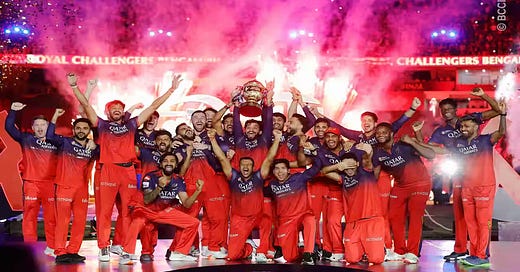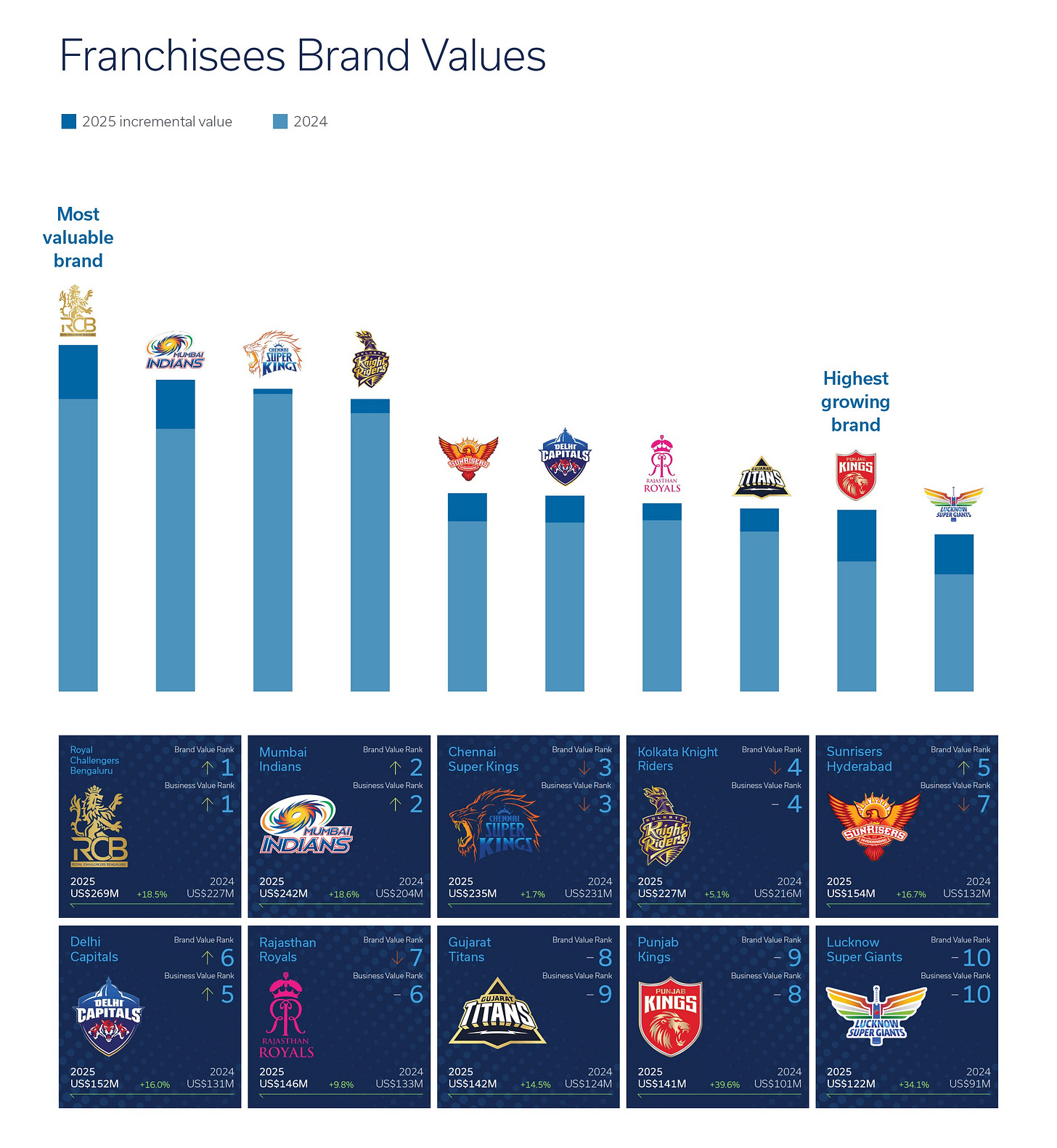IPL values continue to soar - so can we expect the same in The Hundred?
The Houlihan Lokey IPL Valuation Study 2025 finds that the IPL's business value has risen by 13% in the past 12 months, while viewing figures have followed suit.
After a year that has seen unprecedented private investment into English cricket from Indian Premier League (IPL) owners, Houlihan Lokey’s annual study reveals that the business value of the world’s most lucrative cricket competition has soared to US$18.5 billion, a 12.9% uptick in just 12 months.
The stand-alone brand value of the IPL, meanwhile, has increased by 13.8% to US$3.9 billion.
These are extraordinary figures and ones which will have the ECB salivating as they hope that some of the IPL’s magic rubs off on the Hundred in the coming years.
A firm indication of the IPL’s continued growth is the sale of its four associate-sponsor slots.
At a time of plateauing revenues in some major sports, the Board of Control for Cricket in India (BCCI) reported that the sale of four associate-sponsor slots - My11Circle, Angel One, RuPay and CEAT - generated ₹1,485 crores (US$173m), a 25% increase over the previous cycle
The Tata Group also recently extended its title-sponsorship, signing a five-year deal worth a reported US$300m.
Perhaps the most extraordinary figures, though, relate to viewing numbers, which enjoyed further eye-watering growth in 2025.
During the opening weekend (22–24 March), JioHotstar - the IPL’s official streaming platform - recorded 1,370 million views (35% YoY growth), with a peak of 340 million concurrent viewers and 21,860 million minutes watched. Simultaneously, Star Sports drew 253 million unique TV viewers (up 14% YoY), resulting in a combined 49,560 million minutes of watch time.
The final of the tournament - played between Virat Kohli’s Royal Challengers Bengaluru (RCB) and Punjab Kings (PBKS) smashed all previous records out of the park.
The 2025 IPL final recorded more than 67.8 crore (678m) views on JioHotstar, a higher figure than that recorded during the India-Pakistan clash in the ICC Championship in February this year.
Given the competition’s valuation and the exponential increase in the value of the franchises involved, it’s not unreasonable to assume that the Hundred itself has considerable headroom to grow and evolve into a competition that can one day, if not compete with its Indian counterpart, then certainly run it a close second.
The ingenuity and deep pockets of the Indian owners investing in the English game, also hint that the price paid for the Hundred franchises in the first round of investment could well prove to be good value - despite the surprise that greeted some of the sums involved.
Speaking exclusively to Rich and Rob, Harsh Talikoti, a Director in Houlihan Lokey’s Corporate Valuation Advisory Services (CVAS) practice, said: "The valuations outlined in our IPL Brand Study highlight the untapped potential in cricket.
“The IPL has shown the upside possibility when a solid cricket product is backed by strong governance structure, consistent branding, private capital, global investor interest and a massive consumer market.
“Compared to the IPL, The Hundred is still a nascent property and its current valuations are based on what a willing buyer is paying them, but that also means there is a substantial upside.
“With the right commercial and media strategy, The Hundred can grow into a much more valuable asset in the near-future."
The IPL hasn’t just transformed the cricket landscape, it has also acted as a catalyst for the way the T20 game is consumed around the world. It has merged sport and entertainment in a way that was inconceivable before 2008.
“The IPL continues to set benchmarks in sports business. Franchise valuations have soared, media rights deals have reached record highs, and brand partnerships have diversified across sectors,” says Talikoti.
“The league’s ability to attract global investors and sponsors reflects its status as a premier sports property with enduring appeal.
“In summary, the IPL represents a high-yield multi-asset class with diversified risks and a catalyst for cricket’s global transformation. By blending sport, entertainment, and commerce, it has redefined how cricket is consumed and commercialised.
“Its growth trajectory, led by OTT penetration, blend of youthful and diverse audiences, global awareness, and asset creation (IP deals, women’s league, new franchisees) is strong.
“As the sport continues to expand into new territories, the IPL’s blueprint will remain central to shaping the future of cricket on the world stage.”
The value of IPL franchises mirrors the growth seen elsewhere. Royal Challengers Bengaluru (RCB) took top spot in this year’s report, with a brand value of US$269 million, up from US$227 million a year ago.
Mumbai Indians climbed to second place (from fourth last year) with a valuation of US$242 million (US$204 million in 2024).
Chennai Super Kings (CSK) slipped to third with a brand value of US$235 million, up only marginally from last year (US$231 million), following a disappointing season.
As the chart above illustrates, the biggest winner in terms of growth are the Punjab Kings. This year’s runner-up saw their value increase by a staggering 39.6%.
And Satish Menon, the franchise’s CEO, says that the vision that accompanied the original idea behind the formation of the IPL is now being realised.
“From day one, we saw IPL as more than a cricket league—it was a scalable business model with high visibility, secure revenue streams, and strong brand-building potential,” he says.
“It was a heady mix of sports and entertainment, which eventually had the potential to deliver huge audiences and revenues.
“We now operate with the mindset of a media-sport brand with multiple revenue verticals, not just a cricket team—and that’s where real profitability lies.
“Over time, we have built a sustainable sports business—one that spans multiple leagues, drives platform-level content, attracts global brands, and creates IPs that outlast a season.”
Rob’s Takeaways
The IPL is not just a cricket league, it’s a diversified commercial machine; The latest Houlihan Lokey valuation puts the IPL at US$18.5 billion, with its standalone brand worth almost US$4 billion. This tells us that sport enterprise value goes beyond the pitch. The IPL has become a multi-asset class with sponsorship, streaming, branding, real estate, celebrity endorsements, all wrapped into one portfolio. That’s what makes investors salivate: cricket is just the engine, but the real returns are driven by media, marketing, and monetisation.
Private capital is transforming the cricket ecosystem and England is now on the radar; Indian ownership groups are starting to reshape English cricket. Their involvement in The Hundred should be seen less as a foreign incursion, and more as a high-upside bet on undervalued IP. The valuation leap we’re seeing in the IPL - 13%+ brand growth in one year - hints at what’s possible when private equity and media muscle collide. For the ECB, it’s now a question of whether they can build a governance framework robust enough to handle this new investment class.
The Hundred’s headroom is real—but needs a narrative, not just a format; Right now, The Hundred is trading on potential. Valuations are loosely pegged to what investors are willing to pay, rather than intrinsic value. But the upside exists and if (and it’s a big if) the ECB can tell a compelling story, that upside can be significant. The IPL didn’t become a unicorn overnight, it was built on star power, household sponsors, smart tech partnerships, and relentless brand reinforcement. The Hundred needs to move beyond experimentation and towards identity.
Audience data is king, and India is winning that game hands down; The IPL’s digital viewing numbers are frankly staggering: 1.37 billion views on opening weekend, 678 million for the final. That’s not just cricket fans tuning in, that’s culture consumption at scale. This is where UK sport needs to pay attention. If The Hundred can’t become a streaming-first product with real-time engagement baked in, it won’t attract the capital or cut-through needed to scale. Eyes = equity.
What the IPL really teaches us: governance + capital + consumer = sustainable value; The IPL’s biggest trick isn’t just the money or the media, it’s the model. A centralised governance framework (via the BCCI), clear revenue share structures, and freedom for franchises to
activate commercially. It’s a textbook case of aligning institutional support with entrepreneurial execution. The ECB would be wise to borrow liberally from that playbook. if they want The Hundred to be more than a summer diversion.





